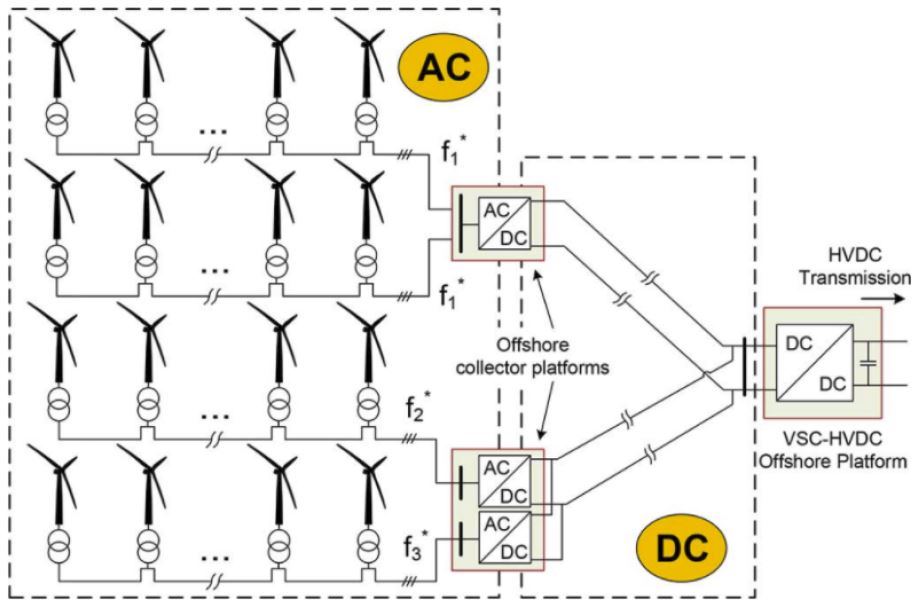offshore wind power plants
A MIP formulation of a Hybrid AC-DC offshore wind power plant topology
Wed, 07/11/2018 - 11:26 — admin| Publication Type | Conference Paper |
| Year of Publication | 2018 |
| Authors | Cristina Corchero; Josep Homs-Moreno; F.-Javier Heredia; Lucia Igualada; Mikel de Prada |
| Conference Name | 23th International Symposium on Mathematical Programming |
| Conference Date | 01-06/07/2018 |
| Conference Location | Bordeaux |
| Type of Work | contributed presentation |
| Key Words | research; hybrid AC-DC; offshore wind power plant; local branching |
| Abstract | The current study analyses a hybrid o↵shore wind farm design in which individual wind turbine power converters are removed from wind turbines and are installed on intermediate o↵shore collector platforms. In this study a compact and small-sized mixedinteger linear optimisation model makes four decisions with the goal of minimising installation and operation costs: the location and the number of o↵shore platforms and power converters to be installed, the optimal wind farm cable layout and the cluster optimal operating frequency of each wind turbine. The solutions found either for small and large o↵shore wind farms improve notoriously real-world designs, reducing up to 8 percent installation and maintenance costs. On the optimization technical results, a variant of Local Branching has been developed, reducing in some cases more than half of computing time with respect to default Local Branching. The model developed serves as a mathematical tool to provide rigorous evidences of the suitability of the hybrid design versus traditional o↵shore wind farm designs. |
| URL | Click Here |
| Export | Tagged XML BibTex |
New MSc Thesis on optimal design of hybrid AC-DC offshore wind power plant topology through MIP.
Thu, 10/12/2017 - 23:00 — admin
 The MSc Thesis entitled A MIP formulation of a Hybrid AC-DC offshore wind power plant topology has been defended by the student Josep Homs, from the Interuniversity Master in Statistics and Operations Research UPC-UB. This work has been advised by myself in collaboration with Cristina Corchero and Lucia Igualada from the Catalonia Institute for Energy Research. This thesis offers a simple, compact and small-sized MIP optimization model that models a hybrid off-shore wind farm design. The model has been tested with small off-sshore wind farms with 24 turbines and 7 platforms locations that may house up to 28 converters. The optimal solution has been obtained within 162 seconds, proving the great potential of the model. Next, the algorithm has been tested with a large realistic case involving 80 turbines and 10 platform locations that may house up to 40 power converters. In this case, the algorithm is able to find a feasible solution 10 milions EUR cheaper than standard current real-world layout designs in just six hours.
The MSc Thesis entitled A MIP formulation of a Hybrid AC-DC offshore wind power plant topology has been defended by the student Josep Homs, from the Interuniversity Master in Statistics and Operations Research UPC-UB. This work has been advised by myself in collaboration with Cristina Corchero and Lucia Igualada from the Catalonia Institute for Energy Research. This thesis offers a simple, compact and small-sized MIP optimization model that models a hybrid off-shore wind farm design. The model has been tested with small off-sshore wind farms with 24 turbines and 7 platforms locations that may house up to 28 converters. The optimal solution has been obtained within 162 seconds, proving the great potential of the model. Next, the algorithm has been tested with a large realistic case involving 80 turbines and 10 platform locations that may house up to 40 power converters. In this case, the algorithm is able to find a feasible solution 10 milions EUR cheaper than standard current real-world layout designs in just six hours.
